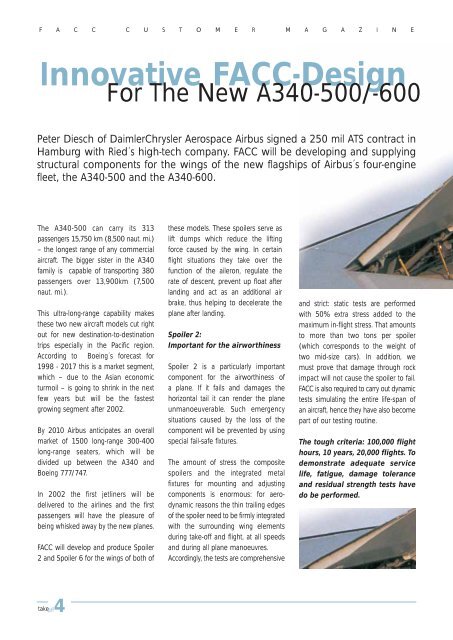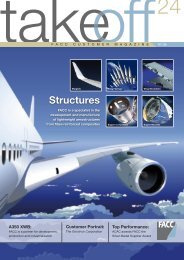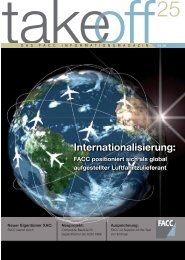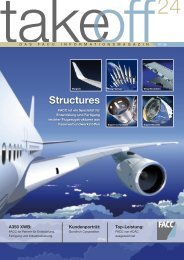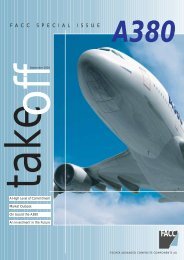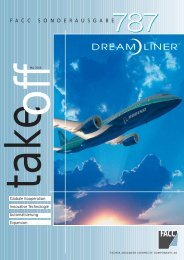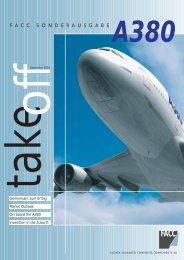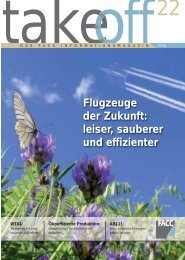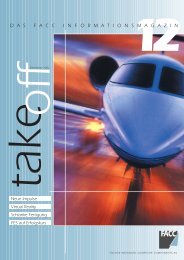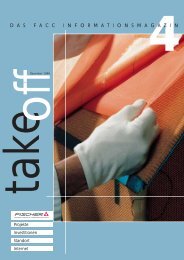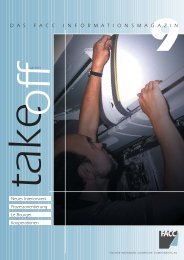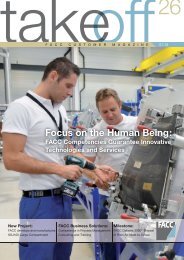You also want an ePaper? Increase the reach of your titles
YUMPU automatically turns print PDFs into web optimized ePapers that Google loves.
F A C C C U S T O M E R M A G A Z I N E<br />
Innovative <strong>FACC</strong>-Design<br />
For The New A340-500/-600<br />
Peter Diesch of DaimlerChrysler Aerospace Airbus signed a 250 mil ATS contract in<br />
Hamburg with Ried´s high-tech company. <strong>FACC</strong> will be developing and supplying<br />
structural components for the wings of the new flagships of Airbus´s four-engine<br />
fleet, the A340-500 and the A340-600.<br />
The A340-500 can carry its 313<br />
passengers 15,750 km (8,500 naut. mi.)<br />
– the longest range of any commercial<br />
aircraft. The bigger sister in the A340<br />
family is capable of transporting 380<br />
passengers over 13,900km (7,500<br />
naut. mi.).<br />
This ultra-long-range capability makes<br />
these two new aircraft models cut right<br />
out for new destination-to-destination<br />
trips especially in the Pacific region.<br />
According to Boeing´s forecast for<br />
1998 - 2017 this is a market segment,<br />
which – due to the Asian economic<br />
turmoil – is going to shrink in the next<br />
few years but will be the fastest<br />
growing segment after 2002.<br />
By 2010 Airbus anticipates an overall<br />
market of 1500 long-range 300-400<br />
long-range seaters, which will be<br />
divided up between the A340 and<br />
Boeing 777/747.<br />
In 2002 the first jetliners will be<br />
delivered to the airlines and the first<br />
passengers will have the pleasure of<br />
being whisked away by the new planes.<br />
<strong>FACC</strong> will develop and produce Spoiler<br />
2 and Spoiler 6 for the wings of both of<br />
<strong>take</strong>off4<br />
these models. These spoilers serve as<br />
lift dumps which reduce the lifting<br />
force caused by the wing. In certain<br />
flight situations they <strong>take</strong> over the<br />
function of the aileron, regulate the<br />
rate of descent, prevent up float after<br />
landing and act as an additional air<br />
brake, thus helping to decelerate the<br />
plane after landing.<br />
Spoiler 2:<br />
Important for the airworthiness<br />
Spoiler 2 is a particularly important<br />
component for the airworthiness of<br />
a plane. If it fails and damages the<br />
horizontal tail it can render the plane<br />
unmanoeuverable. Such emergency<br />
situations caused by the loss of the<br />
component will be prevented by using<br />
special fail-safe fixtures.<br />
The amount of stress the composite<br />
spoilers and the integrated metal<br />
fixtures for mounting and adjusting<br />
components is enormous: for aerodynamic<br />
reasons the thin trailing edges<br />
of the spoiler need to be firmly integrated<br />
with the surrounding wing elements<br />
during <strong>take</strong>-off and flight, at all speeds<br />
and during all plane manoeuvres.<br />
Accordingly, the tests are comprehensive<br />
and strict: static tests are performed<br />
with 50% extra stress added to the<br />
maximum in-flight stress. That amounts<br />
to more than two tons per spoiler<br />
(which corresponds to the weight of<br />
two mid-size cars). In addition, we<br />
must prove that damage through rock<br />
impact will not cause the spoiler to fail.<br />
<strong>FACC</strong> is also required to carry out dynamic<br />
tests simulating the entire life-span of<br />
an aircraft, hence they have also become<br />
part of our testing routine.<br />
The tough criteria: 100,000 flight<br />
hours, 10 years, 20,000 flights. To<br />
demonstrate adequate service<br />
life, fatigue, damage tolerance<br />
and residual strength tests have<br />
do be performed.


